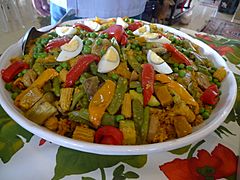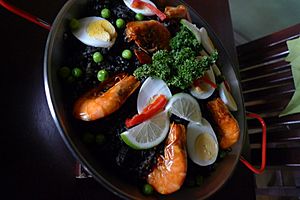Paelya facts for kids

Paelya from Tagaytay
|
|
| Alternative names | paella |
|---|---|
| Course | Main dish |
| Place of origin | Philippines |
| Serving temperature | Hot |
| Main ingredients | glutinous rice, rice |
| Variations | arroz a la valenciana, bringhe, paella negra |
Paelya (pronounced pa-EL-ya) is a yummy rice dish from the Philippines. It's like the Spanish paella, but with a Filipino twist!
What makes it special? Filipino paelya uses sticky rice called malagkít. This makes it soft and a bit sticky, not firm like Spanish paella. You'll often see it topped with sliced eggs. Instead of expensive saffron, Filipino cooks use natural colors from atsuete (annatto), luyang diláw (turmeric), or kasubhâ (safflower) to give it a bright color.
Paelya is a general name for many similar rice dishes in the Philippines. These include arroz a la valenciana (often made with chicken and a special sausage called chorizo de bilbao), bringhe (which uses coconut milk), and paella negra (made with squid ink).
Contents
What's in a Name? The Story of Paelya
The name Paelya comes from the Spanish word paella. In the Philippines, the "ll" sound is often pronounced like "ly" instead of the Spanish "y" sound. This is why it's spelled "paelya" in Filipino. It helps show how the word is said in the Philippines.
How is Filipino Paelya Made?
Paelya is cooked in a similar way to its Spanish and Latin American relatives. However, it uses more local ingredients from the Philippines.
The Rice: Sticky and Flavorful
Instead of arroz bomba rice, Filipino paelya often uses special local rice types. One example is tinawon rice from the Ifugao people, which is similar to arroz bomba. Imported long-grain rice, like jasmine rice, is also used. This regular rice is mixed with glutinous rice (malagkít). The amount of sticky rice can change. It depends on how sticky the final dish should be.
Color and Scent: Natural Filipino Flavors
To give paelya its color, cooks use atsuete (annatto), luyang diláw (turmeric), or kasubhâ (safflower) instead of saffron. Sometimes, a knot of pandán (screwpine) leaves is added. This makes the dish smell a bit like vanilla. Some recipes also use tomato sauce in the sofrito (a cooked mix of ingredients) to add color and flavor.
Meats, Seafood, and Veggies
Meat paelya often has chicken, pork, beef, and spicy smoked sausages. The sausages can be local lóngganisa, but chorizo de bilbao is common. Even though it has "Bilbao" in its name, it's a Filipino sausage!
Seafood paelya usually includes mussels, blue crab, large prawns, clams, and squid. Often, meat and seafood are mixed together.
Common vegetables and spices in paelya are bell peppers, onions, garlic, tomatoes, ginger, carrots, green peas, black pepper, scallions, paprika, and raisins. It's usually topped with calamansi (a small citrus fruit) and sliced hard-boiled eggs. Other local ingredients like tanglád (lemongrass), patís (fish sauce), and bagoóng alamáng (shrimp paste) can also be added.
Cooking and Serving Paelya
Paelya is usually cooked in a paellera. This is a wide, shallow pan with two handles. It can also be cooked in a kawalì, which is like a wok.
Because it uses many ingredients and takes time to make, paelya is not an everyday meal. It's considered a special dish, often saved for important events. Paelya is a popular dish served on Christmas Eve during the Nochebuena (Christmas dinner).
Different Kinds of Paelya
Paelya is easy to change, so there are many different versions. Here are some of them:
Arroz a la Valenciana
Arroz a la valenciana is sometimes seen as its own dish. It came from a Latin American version of paella. But like other Filipino paelyas, it uses sticky rice. It mainly features chicken and chorizo de bilbao. It can also include pork or beef.
Biringi
Biringi (also called bringhi) is a paelya type from Pampanga province. It's similar to the original Spanish dish. However, it uses a mix of regular and sticky rice cooked in gata (coconut milk). It gets its color and taste from saffron or turmeric. It usually has chicken, bell peppers, green peas, carrots, raisins, and chorizo de bilbao. It can also be made with seafood or other meats. It's often topped with sliced boiled eggs. Sometimes, it's cooked in banana leaves for a nice smell.
Biringi has a long history, even before the Spanish came to the Philippines. Its name is similar to South Asian biryani dishes. The original version, without chorizo or eggs, is called nasing biringye. It's more like the nasi briyani from Malaysia and Singapore.
Paella al Horno con Queso
This is a baked version of paelya. It's topped with cheese, chicken breasts, and roasted bell peppers.
Paella de Adobo
This is a newer type of paelya. It was created by Alba Restaurante Español, a well-known Spanish-Filipino restaurant in Manila. It mixes Spanish paella with the famous Filipino adobo dish.
Paella Parillada
This version is named after the Spanish word for "grill." It's topped with grilled or barbecued meat or seafood.
Paella Negra
Paella negra, also called arroz negro, is a type that uses squid ink and calamari. The dish is famously black, which is why it's called "negra" (black). It's very similar to the Spanish arròs negre. But like other Filipino paelyas, it uses sticky rice.
Paella Sotanghon
This paelya has a Chinese influence. It uses glass noodles (sótanghon) instead of rice.
See also
 In Spanish: Paelya para niños
In Spanish: Paelya para niños


